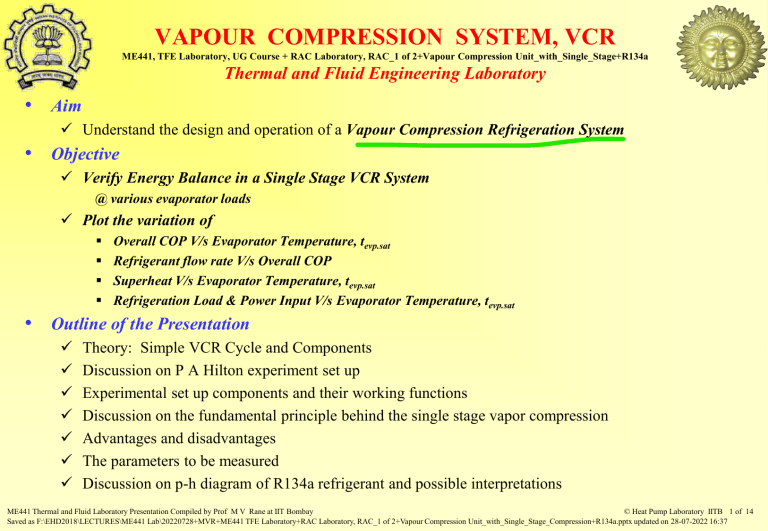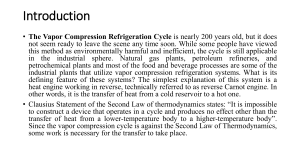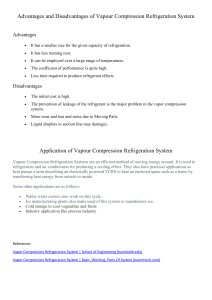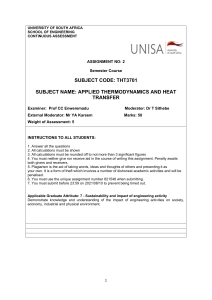
VAPOUR COMPRESSION SYSTEM, VCR ME441, TFE Laboratory, UG Course + RAC Laboratory, RAC_1 of 2+Vapour Compression Unit_with_Single_Stage+R134a Thermal and Fluid Engineering Laboratory • Aim Understand the design and operation of a Vapour Compression Refrigeration System • Objective Verify Energy Balance in a Single Stage VCR System @ various evaporator loads Plot the variation of Overall COP V/s Evaporator Temperature, tevp.sat Refrigerant flow rate V/s Overall COP Superheat V/s Evaporator Temperature, tevp.sat Refrigeration Load & Power Input V/s Evaporator Temperature, tevp.sat • Outline of the Presentation Theory: Simple VCR Cycle and Components Discussion on P A Hilton experiment set up Experimental set up components and their working functions Discussion on the fundamental principle behind the single stage vapor compression Advantages and disadvantages The parameters to be measured Discussion on p-h diagram of R134a refrigerant and possible interpretations ME441 Thermal and Fluid Laboratory Presentation Compiled by Prof M V Rane at IIT Bombay © Heat Pump Laboratory IITB 1 of 14 Saved as F:\EHD2018\LECTURES\ME441 Lab\20220728+MVR+ME441 TFE Laboratory+RAC Laboratory, RAC_1 of 2+Vapour Compression Unit_with_Single_Stage_Compression+R134a.pptx updated on 28-07-2022 16:37 APPARATUS P A Hilton R714/28333 Refrigeration Laboratory Unit Component Description 1 Evaporator with Electric Heater 2 Compressor with External Motor 3 Water Cooled Condenser with Sight Glass 3.1 Isolation Valve 3.2 Filter cum Dryer 3.3 Rotameter for Refrigerant Liquid 4 Thermostatic Expansion Valve, TEV 5 Condenser Cooling Water Valve 6 Main Switch: 7 Evaporator Input Control: 8 Watt Meter & Toggle Switch 9 Temperature Indicator & Section Switch: 10 Tachometer: Indicates Compressor Speed 11 Dynamometer: Enables Measuring Torque 12 Evaporator Pressure Gauge 13 Condenser Pressure Gauge 14 Rotameter for Condenser Cooling Water Power Supply to the Unit EVP Power Enables Measuring Motor and EVP Power Enables Measuring Temperatures ME441 Thermal and Fluid Laboratory Presentation Compiled by Prof M V Rane at IIT Bombay © Heat Pump Laboratory IITB 2 of 14 Saved as F:\EHD2018\LECTURES\ME441 Lab\20220728+MVR+ME441 TFE Laboratory+RAC Laboratory, RAC_1 of 2+Vapour Compression Unit_with_Single_Stage_Compression+R134a.pptx updated on 28-07-2022 16:37 PROCESS SCHEMATIC P A Hilton R714/28333 Refrigeration Laboratory Unit Component Description in Layout 1 Evaporator with Electric Heater 2 Compressor with External Motor 3 Water Cooled Condenser with Sight Glass 3.1 Isolation Valve 3.2 Filter cum Dryer 3.3 Rotameter for Refrigerant Liquid 4 Thermostatic Expansion Valve, TEV 5 Condenser Cooling Water Valve 6 Main Switch: 7 Evaporator Input Control: 8 Watt Meter & Toggle Switch 9 Temperature Indicator & Section Switch: 10 Tachometer: Indicates Compressor Speed 11 Dynamometer: Enables Measuring Torque 12 Evaporator Pressure Gauge 13 Condenser Pressure Gauge 14 Rotameter for Condenser Cooling Water Power Supply to the Unit EVP Power Enables Measuring Motor and EVP Power Enables Measuring Temperatures ME441 Thermal and Fluid Laboratory Presentation Compiled by Prof M V Rane at IIT Bombay © Heat Pump Laboratory IITB 3 of 14 Saved as F:\EHD2018\LECTURES\ME441 Lab\20220728+MVR+ME441 TFE Laboratory+RAC Laboratory, RAC_1 of 2+Vapour Compression Unit_with_Single_Stage_Compression+R134a.pptx updated on 28-07-2022 16:37 APPARATUS P A Hilton R714/28333 Refrigeration Laboratory Unit Important Parts: Evaporator, EVP • A Tubular Evaporator, 1, is Deployed in this Experimental Setup Heat load to the evaporator is provided by an Electric Heater, within the evaporator,1 Additional heat load to the evaporating refrigerant is due to the heat gain through the insulation around the evaporator • Heat Load through the Electric Heater can be Varied by Turning Knob 7 This varies the power input to the electric heater and as a result the evaporator load ME441 Thermal and Fluid Laboratory Presentation Compiled by Prof M V Rane at IIT Bombay © Heat Pump Laboratory IITB 4 of 14 Saved as F:\EHD2018\LECTURES\ME441 Lab\20220728+MVR+ME441 TFE Laboratory+RAC Laboratory, RAC_1 of 2+Vapour Compression Unit_with_Single_Stage_Compression+R134a.pptx updated on 28-07-2022 16:37 APPARATUS P A Hilton R714/28333 Refrigeration Laboratory Unit Important Parts: Open Type Compressor with External Motor • Power from the Motor is Transmitted to the Compressor Using a Belt Drive Diameter of the pulley mounted on the motor and the diameter of the pulley mounted on the compressor govern the compressor speed Speed of the motor and the pulley diameter ration (1.98 in the resent case) decides the speed of the compressor • Compressor Power Measurement can be Enabled by Measuring the Following: Motor Speed, Torque on the Motor Shaft • Motor Speed is Measured Using Tachometer • Torque on the Motor Shaft is Measured Using the Dynamometer Adjusting the sharp edge of the lever end of the dynamometer with the marked arrow next to it and then reading the tension in the force measuring gauge Multiplying the force with the length of the arm gives the torque Using the torque and motor rpm the power delivered by the motor can be calculated • Electrical Power Input to the Motor can be Read from the Wattmeter ME441 Thermal and Fluid Laboratory Presentation Compiled by Prof M V Rane at IIT Bombay © Heat Pump Laboratory IITB 5 of 14 Saved as F:\EHD2018\LECTURES\ME441 Lab\20220728+MVR+ME441 TFE Laboratory+RAC Laboratory, RAC_1 of 2+Vapour Compression Unit_with_Single_Stage_Compression+R134a.pptx updated on 28-07-2022 16:37 APPARATUS P A Hilton R714/28333 Refrigeration Laboratory Unit Important Parts: Condenser, CND, Water Cooled • Water Cooled Condenser, WCC Desuperheats, condenses and subcools compressed refrigerant exiting the compressor • Water Cooled Condensers Typically Offer Lower Condensing Temperatures as Compared to Air Cooled Condensers Cooling water inlet temperature is typically lower than ambient air temperature Heat transfer coefficient with water is better than that with ambient air • Water Cooled Condensers Typically are More Compact Heat transfer coefficient with water is better than that with ambient air In the present system the area of condenser coil, Ahe.cnd = 0.075 m2 • Water Flow Through the WCC can be Measured Using the Rotameter Range of the rotameter is from 4 to 50 g/s & Least Count is 2 g/s Water flow for the experiments are typically set at 30 g/s After setting a value the water flow may vary due to variation in tap water pressure ME441 Thermal and Fluid Laboratory Presentation Compiled by Prof M V Rane at IIT Bombay © Heat Pump Laboratory IITB 6 of 14 Saved as F:\EHD2018\LECTURES\ME441 Lab\20220728+MVR+ME441 TFE Laboratory+RAC Laboratory, RAC_1 of 2+Vapour Compression Unit_with_Single_Stage_Compression+R134a.pptx updated on 28-07-2022 16:37 APPARATUS P A Hilton R714/28333 Refrigeration Laboratory Unit Important Parts: Thermostatic Expansion Valve , TEV • TEV Regulates the Refrigerant Flow from the Condenser Outlet to the Evaporator Inlet • TEV Regulates the Refrigerant Flow to Maintain Super Heat at the Outlet of the Evaporator or Inter of the Compressor Designed to keep the superheating of the refrigerant at a constant level Amount of superheat can be set by setting the adjustment screw provided in the TEV Normally this is factory set and it is not recommended to be tampered with at site • Bulb Type Temperature Sensor Located at the Outlet of the Evaporator is Connected to the Valve by a Capillary Increase in superheat above the set value, increases the pressure in the sensor and the valve opens up to regulate the refrigerant flow • TEV is Expected to Work as an Adiabatic Expansion Device It should be ideally insulated to avoid the frosting seen in the setup ME441 Thermal and Fluid Laboratory Presentation Compiled by Prof M V Rane at IIT Bombay © Heat Pump Laboratory IITB 7 of 14 Saved as F:\EHD2018\LECTURES\ME441 Lab\20220728+MVR+ME441 TFE Laboratory+RAC Laboratory, RAC_1 of 2+Vapour Compression Unit_with_Single_Stage_Compression+R134a.pptx updated on 28-07-2022 16:37 THEORY ME 441 Lab Manual Vapour Compression Refrigeration System, VCRS • VCRS is the Most Commonly Used Refrigeration System Refrigeration/cooling effect is achieved due to evaporation of the refrigerant in the evaporator Evaporation takes place at low temperatures and its vapour pressure is low This low pressure refrigerant is compressed in the compressor Higher pressure refrigerant at the outlet of the compressor is then condensed in the condenser Condensation at higher pressure takes place as higher temperature Enabling heat transfer to is the surrounding of suitable heat sink Condensed refrigerant from the outlet of the condenser is throttled through the Expansion Device and let in to the evaporator • VCRS Works on the Vapour Compression Cycle (VCC) it Consist of Four Steps Isobaric heat extraction in the evaporator Isentropic compression Isobaric heat rejection in condenser Isenthalpic expansion in expansion device • VCC Introduces Two Irreversibilities as Compared to Carnot Cycle Irreversibility due to non-isothermal heat rejection & that due to isenthalpic throttling • Due to These Irreversibilities, the Cooling Effect Reduces and Work Input Increases COP of the VCRS reduces as compared to Carnot cycle ME441 Thermal and Fluid Laboratory Presentation Compiled by Prof M V Rane at IIT Bombay © Heat Pump Laboratory IITB 8 of 14 Saved as F:\EHD2018\LECTURES\ME441 Lab\20220728+MVR+ME441 TFE Laboratory+RAC Laboratory, RAC_1 of 2+Vapour Compression Unit_with_Single_Stage_Compression+R134a.pptx updated on 28-07-2022 16:37 OBSERBVATION TABLE ME 441 Lab Manual Vapour Compression Refrigeration system, VCRS Sr # Measurements Units kN/m2 1 2 3 4 5 6 800 850 950 970 975 1050 100 125 175 200 225 250 oC 7.0 -0.1 2.2 5.2 6.1 9.6 t2 oC 65.0 72.7 63.2 68.8 60.2 70.1 5 t3 oC 29.6 30.5 32.5 34.2 34.3 36.4 6 t4 oC -29.0 -23.7 -15.3 -10.6 -8.2 -5.2 7 t5 oC 28.2 27.5 27.6 28 26.8 28.1 8 t6 oC 30.9 31.1 32.7 33.5 33.0 35.0 9 mw g/sec 30.0 30 32 32 32 0 34 1 pc 2 pe 3 t1 4 kN/m2 ME441 Thermal and Fluid Laboratory Presentation Compiled by Prof M V Rane at IIT Bombay © Heat Pump Laboratory IITB 9 of 14 Saved as F:\EHD2018\LECTURES\ME441 Lab\20220728+MVR+ME441 TFE Laboratory+RAC Laboratory, RAC_1 of 2+Vapour Compression Unit_with_Single_Stage_Compression+R134a.pptx updated on 28-07-2022 16:37 OBSERBVATION TABLE ME 441 Lab Manual Vapour Compression Refrigeration system, VCRS Sr # Measurements Units 1 2 3 4 5 6 10 mr g/s 1.9 2.2 3.2 3.8 4.2 4.5 11 Qeel W 126 210 400 505 603 686 12 Qmel W 343 373 424 451 458 493 13 F N 10.0 10.5 12.0 12.5 13.0 14.0 14 nc rpm 742 743 743 743 743 743 15 nm rpm 1470 1472 1472 1473 1472 1473 ME441 Thermal and Fluid Laboratory Presentation Compiled by Prof M V Rane at IIT Bombay © Heat Pump Laboratory IITB 10 of 14 Saved as F:\EHD2018\LECTURES\ME441 Lab\20220728+MVR+ME441 TFE Laboratory+RAC Laboratory, RAC_1 of 2+Vapour Compression Unit_with_Single_Stage_Compression+R134a.pptx updated on 28-07-2022 16:37 p – h CHART ASHRAE HBF 2017, Ch 30, P 30.17, Fig 8 + Safety Group A1, GWP-AR5 1300, ODP 0 R-134a, HFC, 1,1,1,2-Tetrafluoroethane, CH2FCF3 ME441 Thermal and Fluid Laboratory Presentation Compiled by Prof M V Rane at IIT Bombay © Heat Pump Laboratory IITB 11 of 14 Saved as F:\EHD2018\LECTURES\ME441 Lab\20220728+MVR+ME441 TFE Laboratory+RAC Laboratory, RAC_1 of 2+Vapour Compression Unit_with_Single_Stage_Compression+R134a.pptx updated on 28-07-2022 16:37 CALCULATION ME 441 Lab Manual Vapour Compression Refrigeration system, VCRS • Refrigeration Load Qe = mr (h1 – h4) • Shaft Power Ps = T =2 Nm/60 T = F × 0.165 (arm length for dynamometer) • Friction Power Pf = 0.165 × Ff × Ff = 5N • Indicated Power Pi = Ps - Pf • COP Based on Electrical Power or Overall COP COPep = Qe /Qmel • COP Based on Shaft Power COPep = Qe /Ps ME441 Thermal and Fluid Laboratory Presentation Compiled by Prof M V Rane at IIT Bombay © Heat Pump Laboratory IITB 12 of 14 Saved as F:\EHD2018\LECTURES\ME441 Lab\20220728+MVR+ME441 TFE Laboratory+RAC Laboratory, RAC_1 of 2+Vapour Compression Unit_with_Single_Stage_Compression+R134a.pptx updated on 28-07-2022 16:37 CALCULATION ME 441 Lab Manual Vapour Compression Refrigeration system, VCRS • COP Based on Indicated Power COPip = Qe /Pi • Volumetric efficiency vol = (mr × v1) / Vswept Vswept = 43.0 cm3/rev × rps of compressor • Heat Balance Win = Pi × vol Qcnd = mw Cp (t6 – t5) Win + Qe = Qcnd (Verify Energy Balance) ME441 Thermal and Fluid Laboratory Presentation Compiled by Prof M V Rane at IIT Bombay © Heat Pump Laboratory IITB 13 of 14 Saved as F:\EHD2018\LECTURES\ME441 Lab\20220728+MVR+ME441 TFE Laboratory+RAC Laboratory, RAC_1 of 2+Vapour Compression Unit_with_Single_Stage_Compression+R134a.pptx updated on 28-07-2022 16:37 REFRIGERANTS ASHRAE HBF 2013, Ch 29, 30 Refrigerant Name R-22 Dichlorofluromethane R-134a ODP GWP100 pr tr.critical at 7.2oC at 54.4oC critical bar bar bar Issues o C 0.04 1790 6.3 21.3 50.0 96.1 High GWP Tetrafluoroethane 0 1370 3.8 14.6 40.6 101.1 High GWP R-290 Propane 0 ~20 5.9 19.1 42.5 96.7 Flammable R-600 Butane 0 ~20 1.3 5.5 38.0 152.0 Flammable R-407C R-32/125/134a (23/25/52) 0 1700 6.4 24.0 46.3 86.0 High GWP R-410A R-32/125 (50/50) 0 2100 10.0 34.0 49.0 71.4 High GWP R-717 Ammonia 0 <1 5.6 22.0 113.3 132.3 R-744 Carbon Dioxide 0 1 42.1 SH 73.8 31.0 High pr, Low tcritical R-718 Water/Steam 0.010 0.140 220.6 373.3 Very low pressure, low density Toxic ME441 Thermal and Fluid Laboratory Presentation Compiled by Prof M V Rane at IIT Bombay © Heat Pump Laboratory IITB 14 of 14 Saved as F:\EHD2018\LECTURES\ME441 Lab\20220728+MVR+ME441 TFE Laboratory+RAC Laboratory, RAC_1 of 2+Vapour Compression Unit_with_Single_Stage_Compression+R134a.pptx updated on 28-07-2022 16:37





